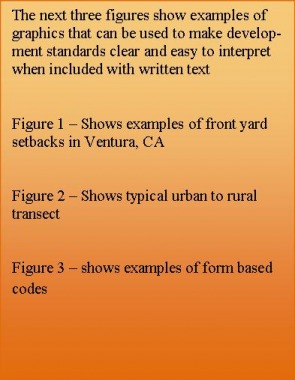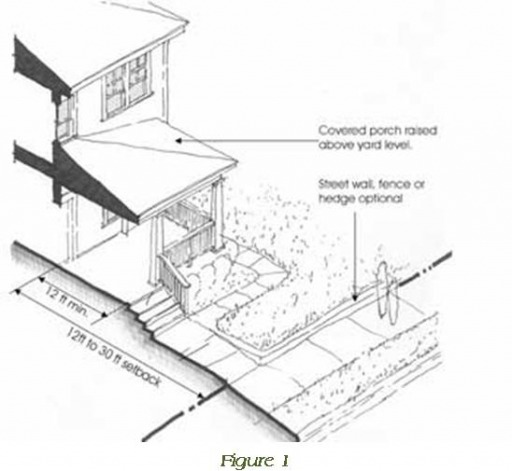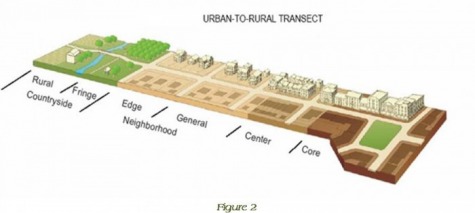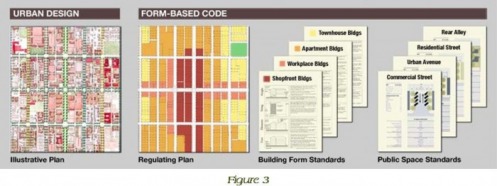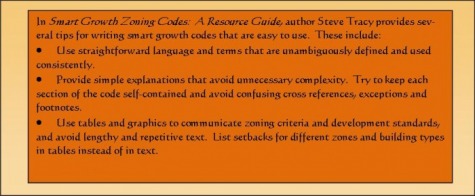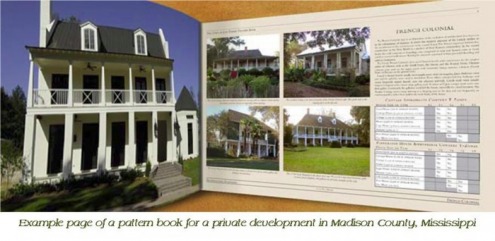For a community to be successful in implementing sustainable growth, its vision, objectives, and actions must be embraced by the private sector. The private sector is crucial for supplying the large amounts of money and construction expertise that is needed to meet the growing demand for sustainable growth developments. If investors, bankers, developers, builders and others do not stand to earn a profit, few sustainable growth projects will ever be built. Government can help to reduce barriers to sustainable growth development practices. Since the development industry is highly regulated, the value of property and the desirability of a place are determined in large part by government investment in infrastructure and by government regulation.
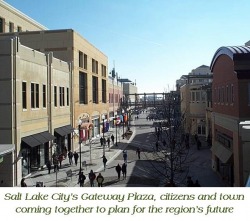
Government investment and regulation shape the types of development that are being created today. Conventional zoning originally used by cities to separate homes from noxious factories has also served to separate homes, stores, schools and offices from one another. As a result, many households are dependent on automobiles to conduct day-to-day activities. This pattern of separate uses is mirrored in the private sector, where developers, investors and bankers are specialized in, and increasingly compartmentalized into, a given type of conventional development, either residential or retail, and develop or finance only projects of that particular type. Building codes that mandate setbacks, parking requirements, and height or density restrictions often make illegal the very type of development that is necessary for sustainable growth.
Despite the many barriers, developers have been successful in creating places that exemplify the principles of sustainable growth. This process often requires them to get variances to zoning codes. This process is often uncertain, time-consuming and costly. Creating more certainty and expediting the approval process for sustainable growth projects is of particular importance for developers who live by the mantra “time is money”. The longer the approval process, the longer a developer’s capital is tied up to the land and not earning income. High interest rates on construction loans, further increase development costs if project approval is delayed. Although sustainable growth neighborhoods generally sell for a premium price, developers continue with conventional suburban developments due to additional efforts required for sustainable growth. Improved public-private cooperation to support sustainable growth projects can help to level the playing field with conventional suburban projects.
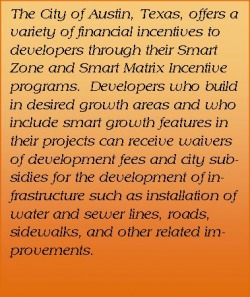
Sustainable growth, as an investment opportunity, offers developers a diverse range of investment-grade options to choose from: brownfields, greyfields, urban infills, transit-oriented projects, pedestrian-oriented projects, and traditional neighborhood development on greenfield sites. For sustainable growth to flourish, state and local governments must make an effort to make development decisions that support innovation in a more timely, cost-effective, predictable way for developers. By creating a supportive regulatory environment for compact, pedestrian-oriented, mixed-use projects, government can create a more attractive investment climate for sustainable growth in which the private sector is more likely to participate.
Making development decisions predictable, fair and cost effective works because:
· Developments that are designed in line with the relevant jurisdiction’s comprehensive plan, ordinances and codes are more likely to progress quickly through the development process
· A fair and consistent process ensures a level playing field whereby all developers are treated equally and pay their fair share of the costs to service new development
· Proper planning and clearly stated community needs will result in new development that contributes to the community it joins
· A fair and consistent process ensures a level playing field whereby all developers are treated equally and pay their fair share of the costs to service new development
· Proper planning and clearly stated community needs will result in new development that contributes to the community it joins
Many lessons have been learned from past successes and failures. Public incentives are becoming more refined. Local approval processes are becoming more streamlined. Developers have a better understanding of their product and how to attract end-users. New solutions are extending beyond individual sites to included districts, and in some instances, entire jurisdictions. Most importantly, there is a heightened level of knowledge, education, and experience that exists for the benefit of all interested parties, who seek to provide new choices in how people can live, work, play and protect the environment.
Sustainable growth must be profitable to receive attention from investors, lenders, developers, and entrepreneurs. While no real estate venture is without challenges, there exists a higher degree of risk associated with sustainable growth development than with single-use projects found within conventional development patterns. In this regard, there is still a lot the public sector can do to reduce the barriers to development, level the playing field, and encourage sustainable growth. It is not enough to focus attention on solutions at a specific site only to repeat the same process on an adjacent parcel. To increase development and reduce risk, local governments should act uniformly and consistently. Such a business practice can communicate a message to developers that greater certainty and predictability exist in the development process.
Strategies that will assist in getting to predictable, fair, cost-effective development decisions include:
- Educate elected leaders and public officials about sustainable growth – citizens expect their public officials to use sustainable growth to make their towns and neighborhoods better, more livable places. Prospects for sustainable development are greatly enhanced when public leaders can clearly articulate a strong vision about how and where growth should occur. Elected and appointed leaders who know the importance of good urban design, scale, diversity, and proper integration of new projects within an existing built environment can achieve higher-quality growth that retains value over time. Understanding these tools and learning how they encourage development require training and education. To meet this challenge, a number of state and national design centers around the country have emerge to teach elected leaders and public officials about sustainable growth.

- Establish a state-or regional-level “sustainable growth cabinet” – development patterns and practices are influenced by many government actions, including transportation projects, infrastructure decisions, housing policies, economic development programs, and environmental protections strategies. Without clear direction and coordination, these agencies, policies and programs can send contradictory messages to the development market. This can be especially true for sustainable growth development given that existing zoning codes, regulations, and ordinances do not accommodate sustainable growth practices as a matter of course. Currently, the approval process for sustainable growth development requires variances and intradepartmental agreement. To make sustainable growth innovation easier than, and more competitive with, conventional development, states have created “cabinets” that are made-up of state-level cabinet members and top executives of agencies and departments. In some form or another, these cabinets set sustainable growth policy, coordinate interdepartmental procedures and programs, review programs for adherence to sustainable growth principles, and resolve conflicts among agencies and departments in the implementation process.

- Engage political support for improved coordination on approval of sustainable growth projects – large mixed-use, infill projects are very complex and usually require numerous approvals from a variety of regulatory agencies. These projects are often the “showcases” sustainable growth projects in an area and they may be seen as the test model for sustainable growth in the region. If a major project succeeds, it can accelerate sustainable growth for an entire region. The success of these projects may hinge on the speed of the review process. Political leaders can use their official position to encourage regulatory agencies to work more closely together and to make such projects a high priority. This coordination can identify and resolve problems quickly and keep a project moving forward. This political support can be one through behind-the-scenes networking or through a visible, institutionalized action.
- Conduct sustainable growth audits – along with a strong political commitment to sustainable growth, one of the most important tools to achieve sustainable growth implementation is a clear evaluation of what is permissible in a given community’s regulatory context. Sustainable growth audits can help point out standards or practices embedded in a jurisdiction’s current operations that limit or prohibit sustainable growth projects from being implemented. By identifying these regulations or practices, local leaders can better prioritized those that need to be modified, and developers can be better informed of the obstacles they are likely to encounter should the attempt to create a sustainable growth project.
- Make development standards clear and easy to interpret – the format of the document that presents development requirements is nearly as important as the standards themselves. Standards should be written in clear language as the legal standard will be tested by the interpretation of the text. Graphics, photos, and illustration should be generously included, but should be used only to supplement the text, not supplant it. Other basic publishing rules should apply as well including a readable typeface, consistent margins, balanced white space, and a thorough index.
Predictability in the development process is valuable to everyone concerned: developers, local government, and community members. Laying out the guidelines and rules for what the local government considers a “good” development project makes the process more predictable and fair, as does defining the benefits developers will get from meeting or exceeding the community’s standards. Two main ways to favor good projects are to offer them flexibility and to speed the approval process.
Flexibility in meeting requirements gives developers room for innovation and creativity, as well as cost savings. If a development project meets or exceeds the community’s goals and vision, the developer should be rewarded with, as an example, a density bonus that allows them to build more in exchange for providing an amenity the community wants, like affordable housing.
Alternatively, local governments can calculate the traffic reduction benefits of a development and adjust accordingly how much parking, road improvements, or air-quality mitigation the developer needs to deliver. Developers tend to favor an approval process in which projects that follow certain guidelines or are located in targeted areas get streamline or fast-tracked approvals. Communities might guarantee review of the project within a certain amount of time, or they might coordinate the various departments that need to review development proposals so that review happens quickly and smoothly.
Of course, the process must include several opportunities for meaningful public input and review and must ensure compliance with other environmental safeguards. Some communities do this by setting out specific desirable criteria; any development that meets these criteria gets a fast track to approval. With the advent of the LEED-ND (leadership in Energy and Environmental Design-Neighborhood Design) green development guidelines, communities have a good starting point for setting standards to define walkable, environmentally responsible neighborhoods.
Following are additional tools to help make development decisions predictable, fair and cost effective.
Encourage demand for sustainable growth through consumer incentives
Strong consumer demand is perhaps the most direct means to create an incentive for private development of sustainable growth projects. The economics of home and auto ownership, supported by post-World War II era government policies that favor buying houses on the edge of urban areas, still persist, despite a growing demand for sustainable growth. Local and state governments can offer incentives to prospective home buyers that would help offset the myriad existing tax, infrastructure, and utility subsidies that currently favor conventional suburban development. New incentives would help level the playing field between conventional and sustainable growth developments, which would give consumers a wider range of choices in the type of community they live in, and which would create more demand for development projects that exemplify sustainable growth principles.
Helping people to live close to work is one such opportunity. Living in proximity to workplaces provides residents with opportunities for improved household choice in transportation and reduced time spent commuting along with the air pollution associated with it. Localities can encourage employers to provide employees with direct financial support, such as low-interest loans or down-payment assistance, to purchase a house near work through employer-assisted housing programs. The Location Efficient Mortgage® (LEM) is another useful tool to increase demand for transit-oriented development by making it easier to qualify for home purchases near transit. A Location Efficient Mortgage® (LEM) is a type of mortgage that recognizes the savings available to people who live in location efficient communities. LEM lenders count this available savings as additional income for people buying homes in location efficient communities. So people who might not otherwise qualify for a mortgage can become homeowners with a LEM, and qualified homebuyers can secure larger mortgages than would otherwise be available to them.
Provide financial incentives to aid the development of sustainable growth projects
While many aspects of sustainable growth offer the opportunity to conserve resources and land costs, some development projects do require additional investment on the part of developers for site infrastructure. Alleys to allow parking in the rear, structured or underground parking lots, sidewalks and bicycle lanes, and parks and other useful open space often add to the cost of a sustainable growth project. While these costs are often reflected in the final price of the projects or may be offset by the lower land costs due to more compact sites, in some cases these additional cost deter developers from initiating sustainable growth.
Communities and states can use a variety of tools to help developers reduce the cost of sustainable growth developments. Local governments can use business improvement districts or tax increment financing to provide funds for sustainable growth infrastructure such as parking, sidewalks, and plazas for commercial areas. Federal transportation dollars can be directed by states or MPOs to make these types of community improvements, to offer more transportation choices near projects, or to clean-up brownfields, and to make infill sites “shovel-ready.” The cost to developers of protecting watersheds and wetlands associated with sustainable growth projects can be reduced by purchasing easements through state clean water and drinking water revolving loan funds. Whatever the funding source, governments’ investments in projects to support sustainable growth should be considered investments in the future viability and livability of their communities.
Create an “incentive expert” for developers and businesses when an area has been designated for development/redevelopment
Many developers are not aware of all the available incentives when considering a sustainable growth project. An incentives expert guides developers through the existing toolkit, recommending incentive options, explaining programs, and providing other advice. If not a specifically created position, this role could be fulfilled by a knowledgeable municipal planner or economic- or community-development director.
Making the development process fair and predictable for developers does not require sophisticated technology but can be accomplished by using available resources more effectively and by minimizing obstacles. The existence of incentives in an area targeted for development welcomes developers. However, even when valuable incentive programs exist, developers often have difficulty navigating the complex maze of paperwork and understanding eligibility requirements.
One way to assist the development process for entrepreneurs is to designate a professional for all inquiries and marketing of incentives. This individual may be assigned to active developers or specifically identified development sites or may serve as a liaison to investors who are considering developing properties that the town desires to have rebuilt. The incentive expert should be well versed in the incentives, the community’s strengths, and the types of development desired.
One way to assist the development process for entrepreneurs is to designate a professional for all inquiries and marketing of incentives. This individual may be assigned to active developers or specifically identified development sites or may serve as a liaison to investors who are considering developing properties that the town desires to have rebuilt. The incentive expert should be well versed in the incentives, the community’s strengths, and the types of development desired.
As an example, Empire State Development of New York provides businesses and investors with such information for new projects and relocated businesses. They also assist decision makers with bond programs, tax and finance incentives, and energy-saving measures, as well as opportunities in different incentive zones. A local government liaison should also possess a list of sites qualified to receive incentives and market those sites accordingly.
Developers perform a complex series of calculations before committing to a project. Some of the factors they consider include financing, market opportunities, ease of entry, timing, and workforce availability. Although a town cannot control many of these factors, it may have already created incentives to reduce the amount of hurdles. An incentives expert can clearly communicate with potential investors and streamline the incentive process, thereby increasing the community’s chances of attracting the type of development it wants.
Create investment funds for sustainable growth projects
A growing number of developers and investors who have completed sustainable growth projects are looking for additional opportunities. Because of their experience, investors are becoming more knowledgeable in identifying the components of a sustainable growth project. Their experience also provides developers with a solid understanding of what to expect in the development process. In short, sustainable growth is becoming more predictable for the seasoned real estate professional. These investors are now poised to identify, through sustainable growth investment funds, opportunities in bulk that produce a “double bottom line” – one that is profitable to investors and supports the goals of sustainable growth.
A number of lending sources have funding initiatives for sustainable growth projects that help create livable communities, support transportation options, and foster sustainable patterns of land use. Other funders support affordable housing and community development, specialize in programs that support low-income and minority communities, or fund the protection of open space. These funders help make development decisions more predictable by providing a stream of capital to developers and communities when conventional funding sources cannot be relied upon.
Use a point-based evaluation system to encourage sustainable growth projects
Most conventional zoning codes offer relatively broad guidelines that define the size and use of buildings. A point-based performance evaluation system for development projects provides a way for communities to evaluate projects in terms of the sustainable growth benefits they provide. Since they are clear and open to the public, the point systems give developers flexibility to determine how they will meet the community’s smart growth goals rather than mandating exactly what amenities are expected.
Communities can develop a point system by first identifying a series of design or service criteria that they want new developments to meet. The next step is to assign points to each criterion to measure how well the proposed project meets community goals. Proposed projects are reviewed against the criteria, and incentives are offered for projects that achieve a predetermined score. For example, Austin relies on very specific criteria concerning design and performance as measured by it Smart Growth Matrix. Projects that fail to meet the desired level can be redesigned during negotiation with planning staff so they can achieve a higher score. Communities can offer a wide range of incentives, such as reduction of development fees, support for infrastructure financing, or density bonuses to encourage the features they desire. The value of the incentives may increase as the project scores increase, with a low level of concessions being given for minimally acceptable scores and more valuable incentives given to higher-scoring projects.
Implement a process to expedite plan and permit approval for sustainable growth projects
Prompt, through review of proposed sustainable growth projects and the timely issuance of permits can reduce the holding cost of land for developers and make smart growth developments more attractive. One-stop shops, developer liaisons, priority review, and review deadlines are just a few ways communities can focus their review resources on projects they want to encourage. Montgomery County, Maryland, for example, created a “Green Tape” review team that helps builders and developers obtain necessary permits more quickly, and the acts as an ombudsman for developers seeking project approvals.
Care must be taken to ensure that there is no real or perceived favoritism when conducting these reviews. These resources can be allocated many ways, including limiting them to specific geographic area (such as special development zones) or by creating a simple version of a self-scored checklist to quickly rank review priority. By meeting their goals for expedited plan and review and improving cooperation with builders and developers in the process, communities can send the message to the private sector that they are open for sustainable growth business.
Make zoning codes and other land development regulations simple to use and easy to read
When considering options under most conventional zoning codes, a developer may spend a great deal of time and expense merely working out what activities or changes are permitted and what are not. In some cases, the code may be written in complicated “legalese” that is difficult for developers (and citizens) to decipher. In others, the code may contain confusing cross-references to other sections of the code, or permitted uses may be spread out in long sections of repetitive text. Simplicity and ease of use benefits all interested parties, because everyone can quickly understand the rules of the game. One reason for this complexity is that many codes are amended several times over many decades, without undergoing a complete update.
Display zoning regulation and design goals in pictorial fashion to better illustrate development goals
Depicting outcomes that are visual in nature through the written word can be a challenge. Conventional zoning regulations are often dense statistical documents, difficult to understand, and sometimes vague. This can lead to confusion and misunderstanding during the permit process, the need for multiple public hearings to resolve disputes, and finally the resubmission of plans and proposals, all of which constitute significant delays and additional costs for developers. Faced with this uncertainty, many developers will simply resort to building what they know they can build right away. The result is often more development that is familiar and conventional and less likely innovative projects that help create sustainable growth.
The concept that a picture is worth a thousand words has helped to inform some communities’ approaches to regulation. They are finding that pictures can help convey to developers, architects, and builders the precise types of developments that the community wants. Providence, Rhode Island found that changing from “zoning by statistics” to “zoning by showing” (what is desired) has created a simple, flexible process for their Downcity redevelopment program. The city of Boulder, Colorado, has encouraged new mixed-use and infill development by designing prototype projects to educate local developers about the preferences that the community had expressed. The planning office had architects create project prototype designs so developers could see exactly what the community was looking to have built. Local developers used these designs as guidelines to build many early mixed-use projects.
Create pattern books to streamline construction and enhance project marketability
A pattern book is an old concept used by builders to establish the basic form of buildings and to provide key architectural elements and detail. Such books provide builders with a variety of renderings and images of acceptable treatments necessary to build a house. By varying the different details and options, builders can create an unlimited number of housing patterns within a common architectural standard, thereby providing each unit with its own unique flair. Such places, both old and new, are highly desirable to homebuyers, and pattern books help ensure the quality and variety of new homes on the market.
Developers are beginning to re-enlist pattern books to assist production builders in the construction of new housing units in sustainable growth projects. This tool serves as an instruction book for builders who traditionally work from their own standard subdivision plans. Pattern books assist the builders in executing the development’s concept as articulated in the project’s architectural and design codes. Not only are pattern books advantageous in the construction process, but developers are finding that they are also a key component of the overall sales marketing program. Pattern books allow for a greater number of housing variations to be created than is commonly found in conventional subdivisions. As a result, consumers have more choices and often like the uniqueness of the product – aspects that distinguish pattern book neighborhoods from cookie-cutter subdivisions that have a small number of product types.
Pattern books are also becoming advantageous to developers during the approval process, as new projects require more community input. Pattern books can help to communicate the proposed master plan’s character to the community and approving officials, and can be used to assure them that “what they see is what they’ll get.” Once general consensus has been reached on a master plan, the pattern book serves as a means to implement it. This process engages builders, developers, architects, and real estate professionals in a more technical process. If prepared correctly, a pattern book can reduce misunderstandings between homeowners, the developer, builders and subcontractors. Pattern books enable all participants to understand, embrace and build from a shared vision.
Create a multimunicipal planning strategy to provide for development in rural markets while maintaining rural character
Some states require their municipalities to create individual land use plans that include all possible zoning uses within its jurisdictions. This challenge can be quire daunting, and for many rural towns such legal requirements can have unintended consequences that impact the rural character of a region. By zoning for all uses, rural communities are placed in a precarious position. The municipalities must designate the future removal of valuable open space for non-compatible uses in rural areas (such as apartments, offices, or industrial complexes), and, moreover, the non-rural uses often diminish the spirit of the community. Under today’s planning measures, these non-rural uses are located in rural regions far from existing centers. The location of such development requires new infrastructure that is costly to implement and maintain. Multimunicipal planning (multiplanning) is being utilized as an effective tool for rural regions to foster economic growth with minimal impact on their rural value.
Multiplanning affords rural communities the opportunity to work together to benefit from growth while protecting rural priorities. The multiplanning strategy blunts some of the distortions introduced by the requirement to plan for all uses. It can reduce the cost of infrastructure by concentrating high-intensity and dense uses in fewer areas. It can also preserve agricultural land and other critical spaces across jurisdictions. From a regional perspective, multiplanning facilitates tax revenue sharing, thus reducing the need for municipalities to compete against one another for commercial development. This allows municipalities to conserve land while still benefiting from nearby commercial or industrial development. Additionally, multiplanning can provide for a consistent set of rules within the planning region, thereby making development more attractive.
There are also a number of incentives for municipalities participating in multiplanning that vary according to state law. In Pennsylvania, participating municipalities do not need to provide for every time of possible use but may collectively spread those uses over regional geographic areas. The municipalities can receive state agency priority funding for such planning and implementation, and there is a greater likelihood that state agencies will rely on multiplanning to make funding and permitting decisions.
To the benefit of developers and investors, multiplanning outlines where the designated growth areas are for an entire region and where rural growth boundaries begin. It saves the developer and investor from fighting individual development battles in each municipality in the Multiplan. It also ensures adequate infrastructure to sustain development where it is deemed appropriate.
Direct development along corridors to create stronger districts
Corridors can function as multipurpose districts that unify a diverse range of neighborhood uses with civic space, link town centers, capitalize on existing infrastructure, and build stronger commercial districts. High-density projects are more appropriately located along corridors, where transportation capacity is greater. Corridors should be planned to conveniently link town centers. This can be accomplished by transit stops for passenger rail, bus, or light rail along boulevards (intra-city) or avenues (inner-city). Well-designed avenues with frequent intersections provide an environment for area residents to walk or bike to local destination nodes. As transportation modes increase, so does commuter access to corridor employment. Transportation planning can position the corridor as a job center to attract new business.
A primary benefit of corridor planning is to create an economic district that is stronger than the sum of its component parts, or the smaller individual center. Merchants, especially national retailers, select new markets based on local demographics, day-time population, transportation options, accessibility, parking, and the prospect for retail synergy. Similarly, office markets are best defined when office buildings are located close to one another. Rather than scattering strip retail centers and office buildings in random fashion throughout a region, the corridor extends development beyond individual centers while still focusing it within established markets. This type of growth reinforces the viability of the individual centers, provides direction for new development, and creates a stronger business district while being more cost-effective for the region.
Remove parking from the development equation through public-private partnerships to build community parking facilities
Parking has a significant impact on the type of development that takes place and the look and feel of the end result community. Prominent voices in development adhere to the belief that parking drive development, as more space is often needed to park card than to house people. This is particularly true for retail development. The prospects for creating sustainable growth on infill sites are often diminished by the requisite amount of parking that is specified in local codes.
While governments can ease the parking burden for developers by reducing excess requirements, governments can also help improve the integration of parking into a community by working with area landowners and developers to finance and build community-owned parking facilities that serve all the surrounding buildings. In so doing, local government removes a sizable portion of site planning and development from the development equation, which makes the project easier to implement. Using local government authority and fees collected from nearby landowners who benefit from the parking service, the community can acquire land and build structured parking facilities and remove the zoning requirements for parking the in the surrounding plots. Creating community parking structures can be particularly useful when localities seek to develop high-density infill and transit-oriented development projects. In creating these lots, the community needs to be very careful about the amount of parking it supplies: too much parking will reduce transit use in the area, and too little parking can make the area undesirable to certain tenants. At the same time, potential lenders for new developments in the area must be educated on the use of community parking facilities, because their own lending requirements may stipulate that on-site parking be provided.
Maximize the value of transit agency property through joint development of transit-oriented development
Many transit agencies have underutilized property or air space over property near rail stations or bus routes. These resources constitute valuable investment opportunities for the private sector, which can be engaged through the joint development process to put land to its highest and best use. Recent changes in federal guidelines have helped to overcome obstacles that previously limited the sale or leasing of these properties and have simplified the process. Transit agencies can modify the criteria that they use to evaluate development proposals to place more emphasis on the potential role of the development in creating sustainable growth. Transit agencies are well-poised to act as key implementers of sustainable growth. As they work with the private sector to develop these parcels, transit agencies can ensure that space is used to create the mixed-use, pedestrian-friendly development that the parcels are naturally suited for.
Besides the potential for sustainable growth benefits, the joint development effort can create benefits for both developers, who get access to valuable property that is near transit and in desirable areas, and transit agencies, who are able to make more profitable use of their real estate assets. Sale or lease of the property generates revenues for the transit system. Increased development near transit centers enables more people to use transit for travel between jobs, shops and home. Finally, the public-private partnership that creates these transit-oriented development opportunities can serve to demonstrate the viability and potential profitability of sustainable growth projects for developers.
Incorporate by-right sustainable growth redevelopment into existing communities’ masterplans
Infill redevelopment projects usually face greater regulatory barriers tan do greenfield sites. This tendency is often a result of more detailed regulatory systems put in place to protect existing residents against any potential adverse effects of redevelopment. While the underlying motives are good, these regulatory frameworks often have the undesirable effect of preventing – or making it difficult to build sustainable growth. In many communities, the zoning code has evolved to a level that, if the current buildings on a wonderful old commercial street were to burn down, it would be illegal to rebuild them. These regulatory barriers often make it nearly impossible to recreate the walkable, mixed-use environments that once existed.
Local government can promote the revitalization of important neighborhoods into sustainable growth communities by changes the planning and zoning regulations in these areas so that compact, walkable, mixed-use transit-oriented projects can be built by right. Such changes allow a developer to purchase the land know that zoning variances will not be required to build a sustainable growth project because the community has approved this type of development in advance. A number of tools, including area plans and overlay zones, can be used to achieve this goal. By eliminating uncertainty from the development equation and permitting this development by right, the community is making a clear statement that developers are welcome to help create sustainable growth.
A wide variety of resources and programs are available to help the San Joaquin Valley region expand its possibilities to make development decisions predictable, fair, and cost-effective. The following listing contains relevant programs, resources and contacts for technical assistance, financial tools and specialized expertise available locally, as well as at the state and national level.
§ List here (to be inserted at a later date)



